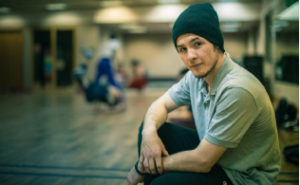
At open practice today, Josh tells me he’s working on power. That means advanced moves such as headspins and flares. He practices alongside 11 year-old Noah who is getting feedback from the older guys on his cracker-jack. These terms describe amazing acrobatic moves that dancers perform on city streets.
Joshua “Text” Perkins, co-founder of the Bboy Federation, aka the “Fed,” says the scene was “fragile” only a few years ago. By 2006, the bboy (break-dancer) community in SLC had dwindled to near non-existence as older dancers moved on and there weren’t enough young dancers to sustain it. Determined not to let the local bboying community die out, Josh and co-founder, James “Pyro” Karren, launched the X-Series which paired older dancers with newer dancers. The X-Series’ success opened the doors for the Bboy Federation, an organization which facilitates battles (bboy and bgirl competitions), classes, coordinates paid gigs for dancers, and promotes the scene.
Although it was a focus of the Fed to bring new kids into the scene, the recent rise in interest and awareness flooded the battles and opportunities that were available, so they have honed in on improving the skills of existing dancers. Josh says that, while anyone is welcome to the open practices, it’s entirely up to the dancer to follow through and show a serious level of commitment to take it to the next level.
The dancers work on acquiring new moves and defining their personal style, and are held to a high standard of professionalism by the Federation. It was only in the past couple of years that people and businesses began to seek out urban-style dancers for hire. The older bboys in the SLC scene know what it was like before this development, but in order to make sure that the kids don’t take this for granted, and also to prove that they’re reliable, professional, and serious, most bboys perform their first show for free.
One of the biggest differences between bboying and nearly any other kind of dance is that, because the dances are considered “street” dances, there aren’t bboying studios as there are for ballet or ballroom. The scene is more underground. Although one can find class offerings through the Bboy Federation, there are no rigid curriculum divsions. Breakers learn basics such as toprocking (dancing to the beat on feet) and handstands long before trying something like a headspin or flares (think windmill with leg-propellers), but no two dancers will have the same learning experience. Also, urban dance focuses on free-style and individuality as opposed to choreography. Josh says that, ideally, the two disciplines could coexist and learn from each other.
To check out bboy classes or events in Utah, visit www.bboyfed.com.





